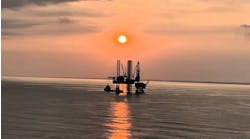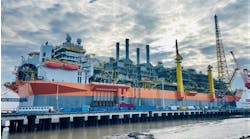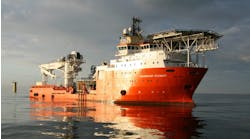Fred Akani
Lagos
Nigeria: accidents create backlash
The wounds of the mid-January oil spill off Nigeria have taken far more balm to heal for Mobil than anyone outside Nigeria would expect. Initially dismissed as a minor injury, Wall Street's immediate reaction to the January 15 spill was: "It's a drop in the bucket for Mobil." This was true.After all, it cost the company only a loss of $2.1 million. The spillage resulted from leak in a 24-in. pipeline running from the Idoho production platform to the Qua Ibo terminal. It would take just one month for Mobil to repair the pipeline and production losses would only be 100,000 b/d of oil.
But, no one reckoned with the level of outrage expressed by the neighboring communities and the amount of local press coverage it would engender. Communities in the immediate vicinity of Mobil's Qua Iboe terminal took to the streets, threatening Mobil personnel, complaining of dead fish washed ashore, among other things. It took the intervention of the military administrator in the host-state to reduce tensions. Mobil's containment of the spill initially caused concern, even though Clean Nigeria Associates assisted. The industry-wide spill containment group is sponsored by all major operators.
The spill was reported to have spread as far as the vicinity of Texaco's Pennington terminal, 325 km to the west. "The communities here (in Pennington) thought it was our oil," said a Texaco spokesman. "We had to bear some of the brunt of it."
In the midst of the din, Mobil took out several one-page advertisements to say, "Sorry." Less than a month after this widely publicized oil spill, in an unrelated incident, Chevron experienced a death during a fire and explosion on Usari-15 (OML 70), located 10 km from Mobil's huge Oso condensate field in the same lease, both offshore Nigeria. The two incidents collectively have cast a shadow on safety records.
Nigeria: competition between majors
For the third year running, Mobil has been the most active multinational operating in Nigeria. The company was producing 675,000 b/d of oil, of which 100,000 b/d was condensate. The company was racing for an average production of 900,000 b/d by the year 2000.This target, from Mobil's pattern of increased activity, seemed within limits. Between March 1996 and October 1997, Mobil increased production of liquid hydrocarbons, from 490,000 to 675,000 b/d of oil. Out of this output, condensate production averaged 100,000 b/d, but an increase in 185,000 b/d within 18 months is high by any standards.
For the past two years, Chevron, Mobil's closest rival in Nigeria, has proposed to increase production from 350,000 b/d in 1996 to 600,000 b/d of oil by 2001. Chevron appears to be on course. Last year, the firm averaged 423,000 b/d of oil. Even giant Shell, which holds about half of Nigeria's 21 billion bbl of oil, has hovered at 900,000-950,000 b/d of oil between 1995 and 1998.
Ekanga-1 well is too political
Elf has described the Ekanga-1 well, drilled on the southeastern tip of the southeast Niger Delta lease OML 102, as "a political well." For this reason, the results of the well are not to be made public. Ekanga-1 is located in 130 meters of water, 3 km northwest of Zafiro-1, in Equatorial Guinea. The general concensus is that it may have been drilled to test the Zafiro accumulation in the Nigerian zone.Unconfirmed sources confirmed that Ekanga-1 encountered oil, but could not disclose the relationship between the find and the Zafiro accumulation. Is it the same field? Elf says that the well is sensitive to the Nigerian Government because the location can be a source of argument between Equatorial Guinea and Nigeria.
Angola: Block 19 is the hot prize
Two independents, United Meridian (UMC) of the United States and Ranger Oil of Canada, last month went to town with the news that they had been awarded participation in deepwater Block 19 offshore Angola. Respectively, they hold 25% and 20% each.Their announcement served more to arouse curiosity about who was the principal partner in the lease and who was going to operate the concession. Block 19 covers about 1.2 million acres and lies in offshore Kwanza Basin in water depths ranging from 300 meters to 1,800 meters. In the last two years, several giant Tertiary oil discoveries have been announced off Angola in nearby Blocks 14 and 17. Block 19 is prospective for both Tertiary and Pinda horizons. Initial activity will include a seismic survey with the first exploratory well anticipated in 1999.
West Africa E&P:
- Marathon has completed both Tchatamba Marine-02a and Tchatamba-S02a in the Kowe permit, offshore Gabon. The field is expected to be on stream in mid-1998.
- Arco has delayed the drilling of Padouca-1, in Otiti Block to the 2nd Quarter 1998 due to lack of rig availability. Reports say the Padouca structure is large - a 25,000 acre closure. It's in a compressional toe-thrust trend, in water depth of 600 meters.
- Until now, South Africa's three-year-old E&P company, Energy Africa, was content to hold small interest in leases off Western and Central Africa. This year, it will operate the Ankanni Block off Gabon. The lease was formerly operated by Conoco, which drilled the Ofma-1 well there in 1992. The well encountered 230 ft of oil pay, which was not tested. Energy Africa proposes to drill in this quarter. Commitments include seismic coverage.
- Exxon's Kissanje-1, the first well in deepwater Block 15 offshore Angola, was sidetracked at 9,700 ft and drilled to 12,200 ft. Kissanje encountered an undisclosed footage of oil before the sidetrack, but the well was only just preparing to test in early February.
- Elf has actively commenced the development of the Moho field, in 2,500 ft of water offshore Congo (Brazaville).The field will be tied in to the N'Kossa platform already operated by the company. Both Elf and her 30% partner Chevron are looking at the possibility of commencing production of the field in 2000. In the same lease, Haute Mer 312, the partners are producing 120,000 b/d of oil and 350 Mmcfld of gas from N'kossa. Testing on Bilondo Marine-1 was abandoned in December 1997. In Libonolo-1, in the same lease, Elf has discovered 200 million bbl of heavy oil. The structure may straddle Cabinda.
Copyright 1998 Oil & Gas Journal. All Rights Reserved.


